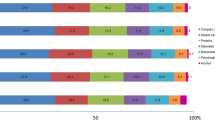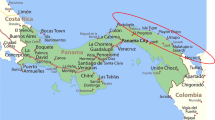Abstract
One late winter afternoon in 2005 in the village of Arsaal in Northeast Lebanon, a meeting to discuss an upcoming project with the community members was wrapping up.
*Malek Batal was team leader for the project: Wild Edible Plants: Promoting Dietary Diversity in Poor Communities of Lebanon, which was funded by IDRC (2004–2007).
**Amin al-Hakimi was team leader for the project: Traditional Yemeni Rural Diets and Local Food Systems: Enhancing Contributions to Health and the Environment, which was funded by IDRC (2005–2008).
Access this chapter
Tax calculation will be finalised at checkout
Purchases are for personal use only
Similar content being viewed by others
Notes
- 1.
In November 2004, the Department of Nutrition and Food Science in partnership with the Initiative for Biodiversity in Arid Regions (IBSAR) and the Environment and Sustainable Development Unit (ESDU) at the American University of Beirut (AUB) started the project Wild Edible Plants: Promoting Dietary Diversity in Poor Communities of Lebanon (WEP-DD).
- 2.
Through partnership between the University of Sana’a, the Yemeni Genetic Resource Center, and IDDEALES, the project Health and Dietary Diversity in Yemen – Traditional Yemeni Rural Diets and Local Food Systems: Enhancing Contributions to Health and the Environment was started in winter 2005.
- 3.
References
Adra, N. (1983). The Impact of Male Migration on Women’s Roles in Agriculture in the Yemen Arab Republic (Arabic, English). Inter-Country Expert Meeting on Women in Food Production in the Near East Region. Amman (Jordan), 22 October 1983. Food and Agriculture Organization of the United Nations, Rome.
Al Hakimi, A., Al Qubati, A., Al Hagami, A., Saed, S.S., Othman, M.D., Al Samawi, A., Yaani Abdulkarim, A. and Pelat, F. (2008). Health and Dietary Diversity in Yemen – Traditional Yemeni Rural Diets and Local Food Systems: Enhancing Contributions to Health and the Environment (Project 103153). Final Technical Report to IDRC. Available at: http://idl-bnc.idrc.ca/dspace/handle/10625/44794
Al-Hakimi, A., and Ya’ni, A.A. (2008). Women and Coping Strategies for Adaptation to Climate Change Using Agrobiodiversity Resources in the Rainfed Highlands of Yemen. Report Prepared for the World Bank, Washington.
Al-Makhlafi, H.K. (1999). Food security in Yemen; An analysis study of the current nutrition situation. Yemeni Journal of Science, 1(1), 1–16.
Aw-Hassan, A., Alsanabani, M., and Bamatraf, A. (2000). Impact of land tenure and other socioeconomic factors on mountain terrace maintenance in Yemen. CAPRI Working Paper. International Food Policy Research Institute, Washington.
Baba, N.H., Hamadeh, S., and Adra, N. (1991). Nutritional status of Lebanese school children from different socioeconomic backgrounds. Ecology of Food and Nutrition, 25, 183–192.
Baba, N., Shaar, K., El-Sheikh Ismail, L., and Adra, N. (1996). Comparison of nutritional status of pre-school children at day care centres and at home from different socioeconomic backgrounds in Beirut. Journal of Human Nutrition and Dietetics, 9(2), 89–103
Batal, M. (2008). The Healthy Kitchen: Recipes from Rural Lebanon. American University of Beirut Press, Beirut.
Batal, M. and Hunter, B. (2007). Traditional Lebanese recipes based on wild plants: An answer to diet simplification? Food and Nutrition Bulletin, 28(2), S303–S311.
Batal, M., Hamadeh, S., Hwalla, N., Kabbani, N., and Talhouk, S. (2007). Wild edible plants: Promoting dietary diversity in poor communities of Lebanon (Project 102692). Final Technical Report to IDRC. Available at: http://idl-bnc.idrc.ca/dspace/handle/10625/38050.
Customs and Ministry of Trade Lebanon. (2009). Trade Statistics. Available at: http://www.customs.gov.lb/customs/trade_statistics/yearly/search.asp.
FAOSTAT. (2004). FAO Statistical Databases. Food and Agriculture Organization of the United Nations, Rome, Italy. Available at: http://faostat.fao.org/faostat/default.jsp.
Government of Yemen. (2002). Poverty Reduction Strategy Paper (PRSP) 2003–2005. Government of Yemen, Sana’a.
Government of Yemen. (2003). Yemen Food Insecurity and Vulnerability Information Mapping System (FIVIMS) Survey Report. Government of Yemen, Sana’a.
Hamadeh, S., Haidar, M., and Zurayk, R. (2006). Research for Development in the Dry Arab Region: The Cactus Flower. Southbound, Penang, Malaysia, and IDRC, Ottawa.
Hashim, A.M.A. (1999). Food security and the nutritional gap in the Republic of Yemen. In: Le Ye’men Contemporain. Editions Karthala, Paris.
Hwalla (Baba), N. (1998). Food and dietary fiber consumption pattern in Lebanon. International Journal of Food Sciences and Nutrition, 49, 41–45.
Hwalla (Baba), N. (2000). Dietary intake and nutrition related disorders in Lebanon. Nutrition and Health, 14, 33–40.
Hwalla, N., Adran, N., and Jackson, R. (2004). Iron deficiency is an important contributor to anemia among reproductive age women in Lebanon. Ecology of Food and Nutrition, 43, 77–92.
Hwalla, N., Sibai, A., and Adra, N. (2005). Adolescent obesity and physical activity. In: Simopoulos, A.P. (Ed.), Nutrition and Fitness: Obesity, the Metabolic Syndrome, Cardiovascular Disease, and Cancer. World Review of Nutrition and Dietetics, 94, 42–50.
Issa, C., Darmon, N., Batal, M., and Lairon, D. (2009). The nutrient profile of traditional Lebanese composite dishes: comparison with composite dishes consumed in France. International Journal of Food Sciences and Nutrition, 60 (S4), 285–295.
Issa, C., Darmon, N., Salameh, P., Maillot, M., Batal, M., Lairon, D. (2011). A Mediterranean diet pattern with low consumption of liquid sweets and refined cereals is negatively associated with adiposity in adults from rural Lebanon. International Journal of Obesity, 35(2), 251–258.
Jeambey, Z., Johns, T., Talhouk, S., and Batal, M. (2009). Perceived health and medicinal properties of six species of wild edible plants in the northeast of Lebanon. Journal of Public Health Nutrition, 12(10), 1902–1911.
Jumaan, A.O., Serdula, M.K., Williamson, D.F., Dibley, M.J., Binkin, N.J., and Boring, J.J. (1989). Feeding practices and growth in Yemeni children. Journal of Tropical Pediatrics, 35, 82–86.
Lofgren, H. and Richards, A. (2003). Food security, poverty, and economic policy in the Middle East and North Africa. Research in Middle East Economics, 5, 1–31.
Ministry of Agriculture and Irrigation. (2007). Agricultural Statistics Yearbook 2007, Ministry of Agriculture and Irrigation, Republic of Yemen.
Melzer, K. (2002). Nutritional status of Lebanese school children aged 6–9 years from different socioeconomic backgrounds. MS Thesis, American University of Beirut, Beirut.
Nasreddine, L., Hwalla, N., Sibai, A., Hamze, M., and Parent-Massin, D. (2006). Food consumption patterns in an adult population in Beirut. Public Health Nutrition, 9(2), 194–203.
Obeid, O.A., Al-Khatib, L., Batal, M., Adra, N., Hwalla, N. (2008). Established and suspected biomarkers of cardiovascular disease (CVD) risk in pre-menopausal Lebanese women. Ecology of Food and Nutrition, 47(3), 298–311.
Raja’a, A., Sulaiman, S.M., Elkarib, S.A., and Mubarak, J.S. (2001). Nutritional status of Yemeni schoolchildren in Al-Mahweet Governorate. Eastern Mediterranean Health Journal, 7(1/2), 204–210.
Raja‘a, A., and Bin Mohanna, M.A. (2005). Overweight and obesity among schoolchildren in Sana’a City, Yemen. Annals of Nutrition and Metabolism, 49, 342–345.
Sibai, A., Hwalla, N., Adra, N., and Rahal, B. (2003). Prevalence and covariates of obesity in Lebanon: Findings from the first epidemiological study. Obesity Research, 11(11), 1353–1361.
UNDP (United Nations Development Programme). (2009). Arab Human Development Report. UNDP, New York.
Varisco, D.M. (1991). The future of terrace farming in Yemen: a development dilemma. Agriculture and Human Values, 8, 166–172.
World Bank. (2007). Making the most of scarcity: Accountability for better water management results in the Middle East and North Africa. World Bank, Washington.
WFP (World FoodProgram, Yemen). (2008). Impact of food security situation on vulnerable children in Yemen. Survey Report, UNICEF Symposium on Child Poverty. Available at: http://sites.google.com/site/globalstudy2/Impactoffoodsecurityonvulnerablechil.ppt?attredirects=1.
WHO (World Health Organization). (1998). Fortification of flour with iron in countries of the Eastern Mediterranean, Middle East and North Africa, Annex 1. Eastern Mediterranean Regional Office, Cairo. Available at: http://whqlibdoc.who.int/hq/1998/WHO_EM_NUT_202_E_G.pdf.
Ya’ni, A., Al-Hakimi, A., Al-Qubati, A., Saed, S.S., Othman, M.D., Al-Samawi, A., and Pelat. F. (2008). Traditional Rural Yemeni Dishes (In Arabic). Sana’a University Press, Sana’a.
Acknowledgments
We thank the communities of Batloun, Kfarnabrakh, Warhaniyeh, Arsaal, and Kuakh in Lebanon and Al-Arafah, Ribat al Qalaa, Masyab, and Saber in Yemen for welcoming us in their midst. We also acknowledge the support of all of the researchers and other project stakeholders. The following people contributed to the material used in this paper: Anhar Yaani, Sadeq Sharaf, Adnan Al-Qubati, Mokhtar Dael, Ahmed Al-Samawi, Darine Barakat, Salma Talhouk, Shadi Hamadeh, Beth Hunter, Cynthia Farhat, Zeinab Jeambey, and Nader Kabbani. IDRC support for this research was provided through the projects 102692 and 103153.
Author information
Authors and Affiliations
Corresponding author
Editor information
Editors and Affiliations
Rights and permissions
Copyright information
© 2012 International Development Research Centre
About this chapter
Cite this chapter
Batal, M., Al-Hakimi, A., Pelat, F. (2012). Dietary Diversity in Lebanon and Yemen: A Tale of Two Countries. In: Charron, D. (eds) Ecohealth Research in Practice. Insight and Innovation in International Development, vol 1. Springer, New York, NY. https://doi.org/10.1007/978-1-4614-0517-7_6
Download citation
DOI: https://doi.org/10.1007/978-1-4614-0517-7_6
Published:
Publisher Name: Springer, New York, NY
Print ISBN: 978-1-4614-0516-0
Online ISBN: 978-1-4614-0517-7
eBook Packages: MedicineMedicine (R0)




